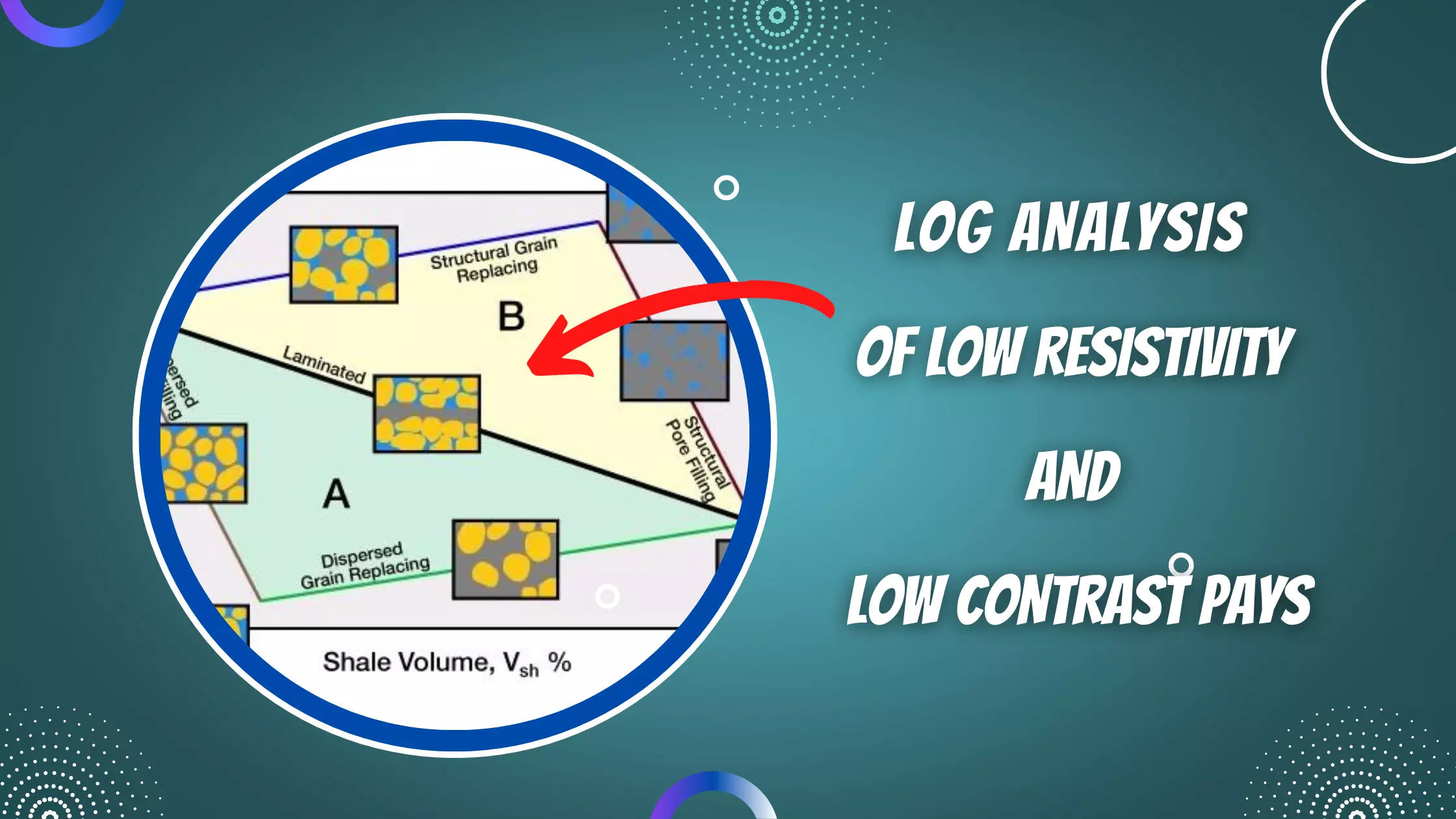Log Calculations
The primary cause of low resistivity pay is water and the clays and shales that attract and hold that water in place. Low resistivity is often caused by bound water, and such low resistivity should not automatically result in a well completed in that interval being a water producer. Various log evaluation methods have been devised to compensate for the presence of clay and shale to estimate a realistic value of the effective water saturation.
In most instances, the steps for correcting for the effects of clay and shale in both the porosity and water saturation calculations are:
- Determine the volume of clay and shale, often termed Vshale (Vsh), in the formation.
- Use the clay/shale volume to correct the total porosity values, and thus, calculate the effective porosity.
- Use the clay/shale volume and the effective porosity to calculate the effective water saturation.
In general, clay and shale have the following effects on both LWD and wireline logging tools:
- Sonic or acoustic porosity values read too high
- Neutron porosity values read too high
- Density porosity values read too high in many situations, except for deep burial and very high compaction of the clays
- Resistivity values read too low
Step 1: Determining the Clay and Shale Volumes
Clay and shale volumes are normally derived from some combination of spontaneous potential (SP), natural gamma ray or spectral natural gamma ray, and crossplotted, or combined, neutron and density logs.
- The various natural gamma ray logs, including spectral gamma ray logs, detect clay and shale by an increase in the natural gamma ray radiation.
- The SP log detects clay and shale by a decrease in the SP deflection caused by the loss of ionic permeability in the shaly sections.
- The neutron and density log, in combination, determine the shale volume by the use of the density-neutron crossplot. Figure 1, Figure 2, and Figure 3 show the crossplots for the three clay distribution models.
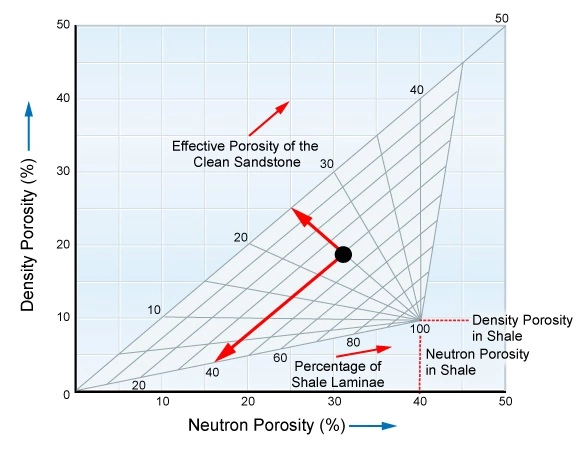
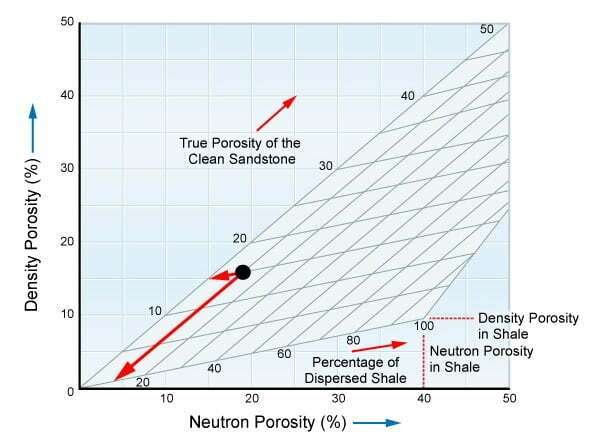
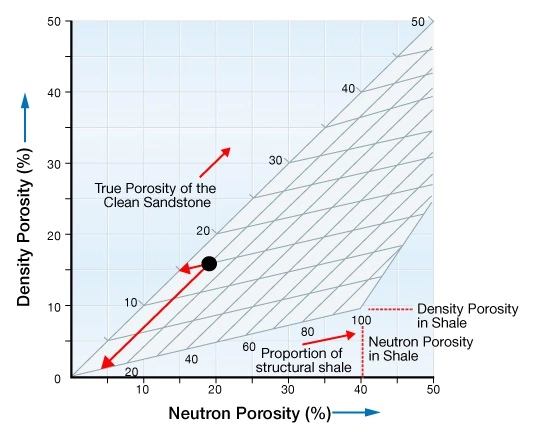
Shale and Clay Volume from the Gamma Ray Logs
The most frequently used technique to derive the amount of clay and shale in a formation is by using the relative deflection of the gamma ray as a shale volume indicator. The simplest procedure is to rescale the gamma ray between its minimum and maximum values from 0% to 100% shale. The gamma ray index (IGR) is used to linearly rescale the gamma ray between GRmin and GRmax.
- Calculate IGR:
![]()
Where:
IGR= Gamma ray index
GRlog= Gamma ray reading from shaly sand
GRmin= Gamma ray minimum from clean sand
GRmax= Gamma ray maximum from shale
- Determine if the sand is consolidated or unconsolidated.
- Use the IGR value to calculate the clay and shale volume, dependent on whether the sand is consolidated or not:
![]() (for consolidated sands)
(for consolidated sands)
![]() (for unconsolidated sands)
(for unconsolidated sands)
Alternatives for Estimating Shale Content from Gamma Ray Logs
Several studies indicate that the method of using the relative deflection of the gamma ray as a shale volume indicator does not always offer the best approach does not always offer the best approach as it tends to overestimate the formations shaliness, so alternative relationships have been proposed. The alternative relationships can be stated in terms of IGR as follows:
| Relationship | Equation |
|---|---|
| Linear | |
| Clavier | |
| Stieber | |
| Bateman |
In the Bateman equation, the gamma ray factor is a number chosen to force the result to imitate the behavior of either the Clavier or the Stieber relationship. Figure 4 illustrates the differences in the calculated shale volumes between these alternative relationships.
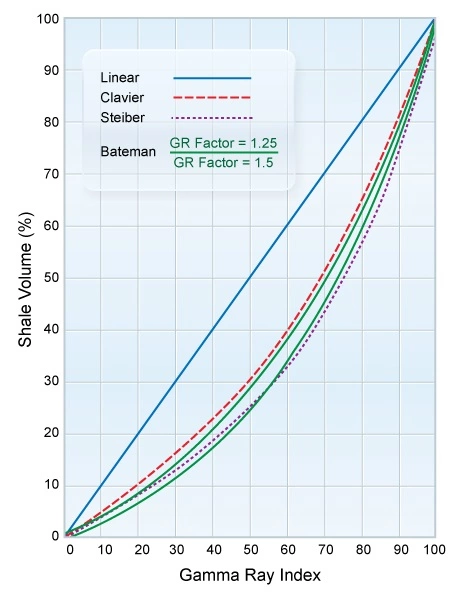
Not all clay and shale minerals are radioactive, and not all sandstones are non-radioactive. For example, because kaolinite contains no potassium, it would tend to mimic clean sandstone, if only the gamma ray log was to be used to determine the shale content. Conversely, when a gamma ray tool measures a sandstone containing a significant amount of potassium feldspars, the log will read higher and could potentially lead to the incorrect conclusion of more shale being present than was actually in the formation.
Clay and Shale Log Volume Calculations from SP Logs
Clay and shale volume can also be calculated from the spontaneous potential log:
![]()
Where:
Vcl= Volume of clay
PSP= Pseudo-static spontaneous potential (SP reading in shaly sand)
SSP= Static spontaneous potential (SP in thick clean sand)
Clay and Shale Volume from Neutron and Density Log Combinations
The combination of neutron and density curves provides another method for estimating the clay and shale volume:
![]()
Where:
Vcl= Volume of clay
ϕn= Neutron porosity in shaly sand
ϕd= Density porosity in shaly sand
ϕnsh= Neutron porosity of adjacent shale
ϕdsh= Density porosity of adjacent shale
If the shaly sandstone is gas bearing, then the shale volume should not be determined from the neutron density log, as the presence of gas will affect these logs, especially the neutron porosity.
Using the Lowest of the Clay and Shale Volume Estimates
The volume of clay and shale can be provisionally estimated by using all three methods described above, after which, the lowest estimate should be applied to shale corrections for porosity and saturation formulas because the various shale indicators will tend to overestimate the shale content.
Step 2: Using the Clay and Shale Volume Estimates to Correct the Porosity
The presence of clay and shale in a formation complicates the way in which porosity is calculated within the reservoir. Though the layer of closely bound surface water on the clay particle can represent a substantial amount of porosity, this porosity cannot be counted as part of a potential conventional resource reservoir for hydrocarbons. So, while a shaly formation may exhibit a high total porosity, it may only have a low effective porosity as a potential conventional hydrocarbon reservoir.
Techniques to Correct Porosity Logs for the Volume of Clay and Shale
Sonic Log
![]()
Where:
ϕe= Effective porosity (acoustic log corrected for clay)
Δtlog= Interval transit time of shaly formation
Δtma= Interval transit time of the formation matrix
Δtfl= Interval transit time of fluid (either 189 for fresh mud, or 185 for salt mud)
Δtsh= Interval transit time of adjacent shale
Vcl= Volume of clay
Density Log
![]()
Where:
Vcl= Volume clay
ϕe= Effective porosity (density log corrected for clay)
ρma= Density of the formation’s clay-free matrix
ρb= Bulk density of shaly formation
ρfl= Density of fluid (1.0 for fresh mud and 1.1 for salt mud)
ρsh= Density of adjacent shale
Combination Neutron and Density Logs
![]()
![]()
![]() for oil
for oil
 for gas
for gas
Where:
ϕe= Effective porosity (neutron and density logs corrected for clay)
ϕn= Neutron porosity of shaly formation
ϕd= Density porosity of shaly formation
Vcl= Volume of clay
ϕnc= Neutron porosity corrected for clay
ϕdc= Density porosity corrected for clay
ϕnsh= Neutron porosity of shale
ϕdsh= Density porosity of shale
Thomas-Stieber Method
Thomas and Stieber (1975) developed an interpretation model to quantitatively determine the shale content and distribution as an alternative to the linear, IGR, method. This model relates variations in the gamma ray response to the concentration and distribution of shale. When this information is later combined with the porosity data, it is possible to determine the shale configuration, sandstone fraction and sandstone porosity.
This model works on the assumption that shaly sandstones and their interbedded shales are mineralogically similar to those shales above and below the sandstone. This will not be the case for the diagenetic alteration of feldspars into clay within the sandstones. The model was developed for geologically young sandstone and shale intervals but was not designed for complicated mineralogies involving carbonates.
Thomas and Stieber start by defining the relationship between the gamma ray count rates and the shale fraction. The shale models are divided into three distinct groups: dispersed, laminated, and structural.
Dispersed Shale Model
For the dispersed shale model (Figure 5), Thomas and Stieber began by developing a formula to show that the observed gamma ray count rate is proportional to the amount of shale added to the pore system.
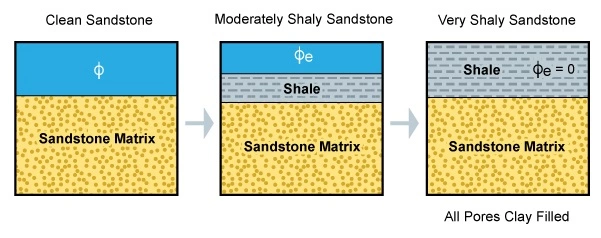
According to their notation, the count rate, R, equals the count rate of sandstone, Ra, plus the count rate of shale, Rb, multiplied by the fraction of sandstone occupied by the shale, Xb:
![]()
Where:
R= Count rate
Ra= Count rate of a solid block of sand material
Xb= Fraction of total rock volume occupied by dispersed shale
Rb= Count rate in shale
Applying this count rate to the gamma ray log, Thomas and Stieber relate to ![]() , which correlates to porosity in terms of Xb, the bulk volume fraction occupied by shale. We can express the value of
, which correlates to porosity in terms of Xb, the bulk volume fraction occupied by shale. We can express the value of ![]() in a sandstone stratum in terms of gamma ray readings:
in a sandstone stratum in terms of gamma ray readings:
![]()
or
![]()
The measure of sandstone radioactivity (ζ) is defined as:
![]()
For dispersed shales, the relation between ![]() and Vsh then becomes:
and Vsh then becomes:
![]()
This can be expressed as:

The minimum porosity available to the dispersed model occurs when shale completely fills all the original pore volume of the sandstone, or when Xb=ϕa.
The minimum dispersed porosity equals:
![]()
Where:
ϕa= Porosity of sand
ϕb= Porosity of dispersed shale
When Xb>ϕa, then the relation between ![]() an Vsh then becomes
an Vsh then becomes ![]()
Laminated Shale Model
In the laminated shale model (Figure 6), shale is added to the sandstone stratum when a corresponding sandstone volume is filled with shale:
![]()
The count rate in the laminated model is actually the sandstone fraction.
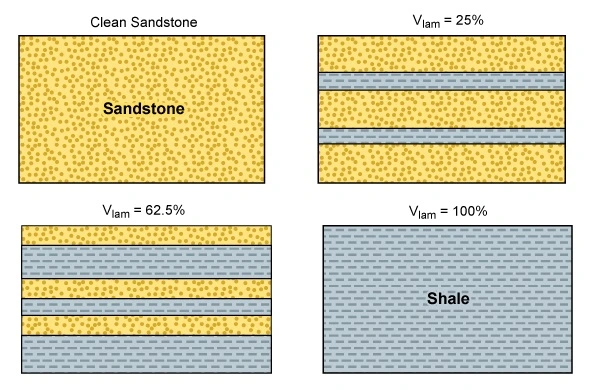
Structural Shale Model
In the structural shale model (Figure 7), the porosity increases with the amount of shale porosity that is added in place of the solid sand grains:
![]()
Thomas and Stieber use the prime (‘) symbol to denote a change in counting yield due to a change in geometry in the material measured. In the structural model, the relationship between count rate and the shale volume is identical to that for the laminated model.
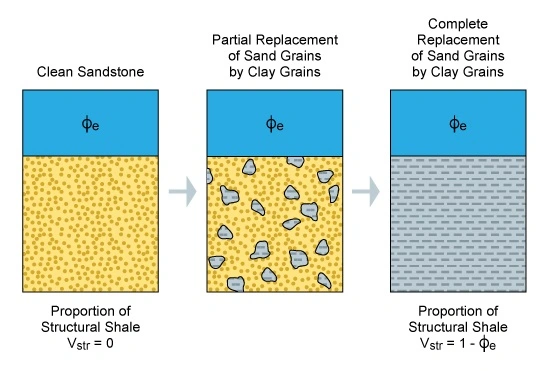
Correlating Count Rates to Porosity
After Thomas and Stieber defined the relation between ![]() and the shale fraction, they next constructed a theoretical
and the shale fraction, they next constructed a theoretical ![]() -porosity relationship based on the three models of shale distribution.
-porosity relationship based on the three models of shale distribution.
Dispersed Shale Model
Thomas and Stieber defined two relationships for dispersed shale:
Starting with pure sandstone, they added some amount of shale to that volume. Then Thomas and Stieber defined dispersed shale porosity as:
![]()
In this case, where Vshale<ϕsand, the pore space is decreased by the amount of shale added (exclusive of the pore space contained in the shale).
When Vshale=0, then maximum ϕdis=ϕsand, and when Vshale=ϕsand, then minimum ϕdis=ϕsand⋅ϕshale. The relationship between count rate and porosity is:
![]()
Where:
ϕdis= Dispersed porosity
ϕa= Porosity of sand
ϕb= Porosity of shale
![]() = Count rate
= Count rate
ζ= Radioactivity of sand
For the second of the two relationships, Thomas and Stieber began with pure shale, added some amount of individual sand grains and then defined the dispersed shale porosity as:
![]()
In this case, total porosity is reduced by the amount of sand grains added:
![]()
The relationship between count rate and porosity is:
![]()
when ![]() then
then ![]()
Laminated Shale Model
For the laminated shale model, Thomas and Stieber replaced both the porosity and the solid rock fraction of the sandstone by shale porosity and the solid rock fraction of the shale:
![]()
The relationship between the count rate and porosity is:
![]()
When ![]() then
then ![]() and when
and when ![]() then
then ![]()
Structural Shale Model
In the structural shale model, the sandstone porosity is not changed but solid rock is replaced by an equivalent bulk volume of shale porosity:
![]()
The relationship between the count rate and porosity is:
![]()
The maximum amount of structural shale which can be added equals the grain volume of the sandstone:
![]()
For structural shale models, the count rate is related to the porosity and radioactivity of the sandstone by the equation:
![]()
Step 3: Calculating the Effective Water Saturation
Many water saturation equations have been proposed since Archie developed his original equation, some of which are detailed in Table 3.
| Table 3: Some Commonly Used Water Saturation Equations | |
|---|---|
| Authors | Formula |
| Poupon, et al. (1954) | |
| Hossin (1960) | |
| Simandoux (1963) | |
| Waxman and Smits (1968) | |
| Bardon and Pied – Modified Simandoux (1969) | |
| Poupon and Leveaux (1971) | |
| Schlumberger (1972) | |
| Clavier, et al. (1977) | |
| Juhasz (1981) | |
As Doveton (2001) observed, “the extension of Archie’s empirical model to shaly sandstones requires the evaluation of more elaborate, and frequently contentious, alternative models.”
The log interpretation methods described here are just a few of the numerous methods that now exist for determining water saturation of shaly sandstones (Figure 8).
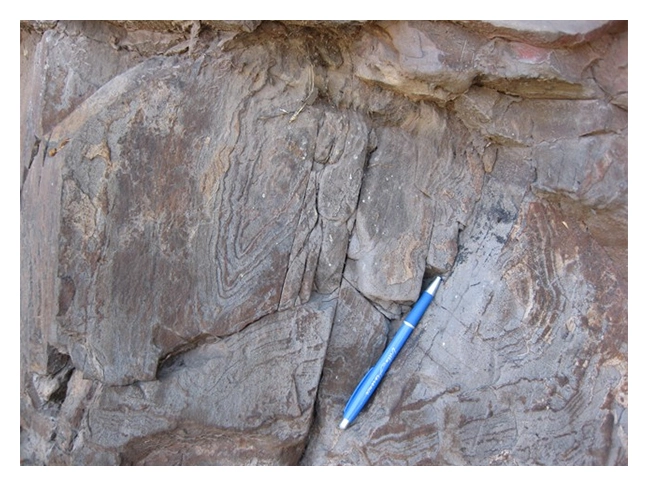
They are relatively simple to use and, with the exceptions of the Waxman-Smits and Juhasz equations, require only basic log data consisting of resistivity, SP, gamma ray, acoustic or sonic, neutron porosity and density LWD or wireline logs. These techniques account for the clay and shale in the formation.
When other contributors, such as heavy minerals, volcanics or other exotics, are thought to cause the low resistivity, then a more extensive suites of logs (including nuclear magnetic resonance, array induction and multi-component induction logs) can be used to investigate the problem. Furthermore, certain techniques have been developed for specific geographical areas of the world. In such cases, local knowledge should guide the selection of the appropriate log evaluation technique.
Dispersed Clay Method
Asquith (1990) states that the acoustic log detects the dispersed clay in the pore water as slurry and generates a porosity value that is equal to the sum of the volumetric fraction. The density log detects only water-filled porosity (Dewan, 1983). The fraction of the clean sandstone intergranular pore space occupied by clay is termed q:
![]()
Where:
ϕs= Acoustic porosity uncorrected for clay
ϕd= Density porosity uncorrected for clay
The effective water saturation equation is:

Where:
Swe= Effective (clay-corrected) water saturation
ϕs= Acoustic porosity uncorrected for clay
Rw= Formation water resistivity
Rt= Deep formation resistivity
![]()
An important aspect of the dispersed clay model is that the equation does not require a value for the shale resistivity, Rsh, or the volume of clay, Vcl, because the shaly factor, q, is determined within the shaly sandstone.
The effective porosity equation is:
![]()
Where:
ϕe= Effective porosity corrected for clay
ρma= Matrix density
ρb= Bulk density from shaly sand
ρfl= Fluid density
ρsh= Shale density
Vcl= Volume of clay
The dispersed clay method for determining water saturation may be unreliable in gas-bearing sandstones because the density porosity may be greater than the acoustic porosity.
Fertl Method
This method, developed by Walter Fertl, can be used for dispersed clays or when the clay or shale distribution is unknown, because this equation does not require a value for the shale resistivity, and thus, avoids the risk of plugging in an Rsh value from an adjacent shale bed that might not represent the actual shale resistivity within the shaly sandstone. (Asquith notes that the difference in resistivities between dispersed clay in the reservoir and the resistivity of the adjacent shale is especially pronounced when resistivity of the adjacent shale is greater than the resistivity of the shaly sandstones.)
![Rendered by QuickLaTeX.com S_{we} = \dfrac{1}{\phi _d} \cdot \left[ \sqrt{\dfrac{R_w}{R_t} + \left( \dfrac{\alpha \cdot V_{cl}}{2} \right)^2} - \dfrac{\alpha \cdot V_{cl}}{2} \right]](https://petroshine.com/wp-content/ql-cache/quicklatex.com-11211a47028d23be68c3a1df45bfae4f_l3.png)
Where:
Swe= Effective (clay-corrected) water saturation
ϕd= Density porosity uncorrected for clay
Rw= Formation water resistivity
Rt= Deep formation resistivity
Vcl= Volume of clay
α= 0.25 in the Gulf Coast or 0.35 in the Rocky Mountains
The effective porosity is derived from neutron and density logs that have been corrected for clay and shale content.
Simandoux Method
Water saturation equations that require a shale resistivity component, Rsh, will generate higher water saturations than those provided by the standard Archie equation when the resistivity of the adjacent shale is greater than the resistivity of the shaly sandstone.
In general, the ![]() term is appropriate only in laminated shaly sandstones. Therefore, whenever it has been established that the shale distribution is laminated (such as by reviewing slabbed full diameter cores [Figure 9]), it is advisable to use either the Simandoux method or the dual water method, which is discussed later in this subject.
term is appropriate only in laminated shaly sandstones. Therefore, whenever it has been established that the shale distribution is laminated (such as by reviewing slabbed full diameter cores [Figure 9]), it is advisable to use either the Simandoux method or the dual water method, which is discussed later in this subject.
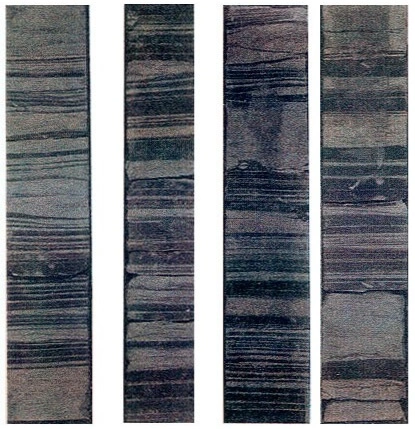
The reason for restricting the value of Rsh to laminated shaly sandstones is that clays in the shaly laminated sandstone and the adjacent shale are both depositional in origin and, thus, may differ significantly in resistivity:
![Rendered by QuickLaTeX.com S_{we} = \dfrac{C\cdot R_w}{\phi _e^2} \cdot \left[ \sqrt{\dfrac{5\cdot \phi _e^2}{R_w\cdot R_t} + \left( \dfrac{V_{cl}}{R_{sh}} \right)^2} - \dfrac{V_{cl}}{R_{sh}} \right]](https://petroshine.com/wp-content/ql-cache/quicklatex.com-0e0f544c3a27fe4b8224f3ec15c177f0_l3.png)
Where:
Swe= Effective (clay-corrected) water saturation
ϕe= Effective porosity corrected for clay
Rsh= Resistivity of adjacent shale
Rw= Formation water resistivity
Rt= Deep formation resistivity
Vcl= Volume clay
C= 0.40 sandstones and 0.45 for carbonates
The neutron and density porosities are corrected for clay and shale to obtain the effective porosity, ϕe, using the method described by Dewan (1983).
Modified Simandoux Method
The Simandoux equation was later fine-tuned as more case studies with dispersed shale were completed and real data was incorporated:

Where:
Sw= Water saturation
F= Formation factor
Rw= Formation water resistivity
Rt= True resistivity
Rsh= Resistivity of adjacent shale
Vsh= Volume of shale
Dual Water Model
The dual water model (Clavier et al., 1977) works on the basis of partitioning the pore water into bound water and free water, each of which contributes to the resistivity of the shaly sandstone. The bound water and the free water have their own associated resistivities, Rb and Rw respectively. In this model, Rb is fresher than Rw, which can move freely within the pores. Following is a summary of the dual water formulation:
1. Calculate the volume of clay and shale, as previously described.
2. Correct the neutron and density porosities for the effects of clay and shale.
![]()
![]()
Where:
Vcl= Volume of clay
ϕd= Density porosity
ϕn= Neutron porosity
ϕnc= Neutron porosity corrected for clay
ϕdc= Density porosity corrected for clay
ϕdsh= Density porosity of shale
ϕnsh= Neutron porosity of shale
3. Calculate the effective porosity
![]() oil zone
oil zone
 gas zone
gas zone
Where:
ϕe= Effective porosity corrrected for clay
ϕnc= Neutron porosity corrected for clay
ϕdc= Density porosity corrected for clay
4. Calculate the total porosity of the adjacent shale.
![]()
Where:
ϕdsh= Density porosity of shale
ϕnsh= Neutron porosity of shale
5. Calculate the total porosity and the bound water saturation.
![]()
![]()
Where:
Sb= Clay-bound water saturation
ϕt= Total porosity
ϕe= Effective porosity
Vcl= Volume of clay
ϕtsh= Total porosity of adjacent sahle
6. Calculate the bound water resistivity from the adjacent shale.
![]()
Where:
Rb= Bound water resistivity
Rsh= Resistivity of adjacent shale
Asquith warns that the shale resistivity, Rsh, is only equal to the resistivity of the clay in the shaly sandstone when the clay in the sandstone is allogenic. When the effective water saturations calculated from equations that require Rsh are much higher than the effective water saturations calculated from equations that do not require a value for Rsh, then dispersed authigenic clay is probably present.
7. Calculate the apparent water resistivity, Rwa, in the shaly sand.
![]()
Where:
Rwa= Apparent water resistivity
Rt= Deep formation resistivity
ϕt= Total porosity
8. Calculate the total water saturation corrected for clay
![]()
Where:
Swt= Total water saturation corrected for clay

Rw= Formation water resistivity
Rwa= Apparent formation water resistivity
9. Calculate the effective water saturation, Swe, of the shaly sandstone
![]()
Where:
Swe= Effective water saturation
Swt= Total water saturation
Sb= Clay bound water saturation
Waxman-Smits Method
Crystal surfaces absorb water using their ion exchange sites (Figure 10). Different minerals have different cation exchange capacity (CEC) values.
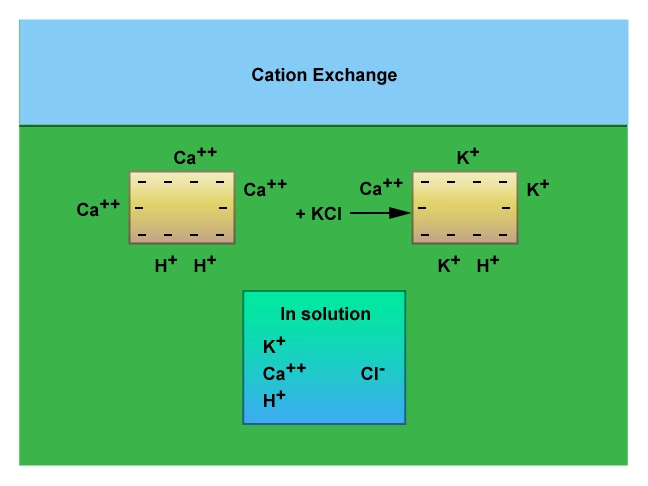
Quartz, as the major constituent of sandstone, has practically no CEC, but illite and montmorillonite (Figure 11), because of their high specific surface areas, have high CEC values. Thus, CEC is a mechanism by which clay can suppress the formation’s resistivity, causing lower values of the petrophysical parameters m and n, but if the cation exchange capacity is ignored, there is the risk of estimating water saturations that are erroneously high. This may cause hydrocarbon productive zones to be overlooked or result in low hydrocarbon-in-place estimates.
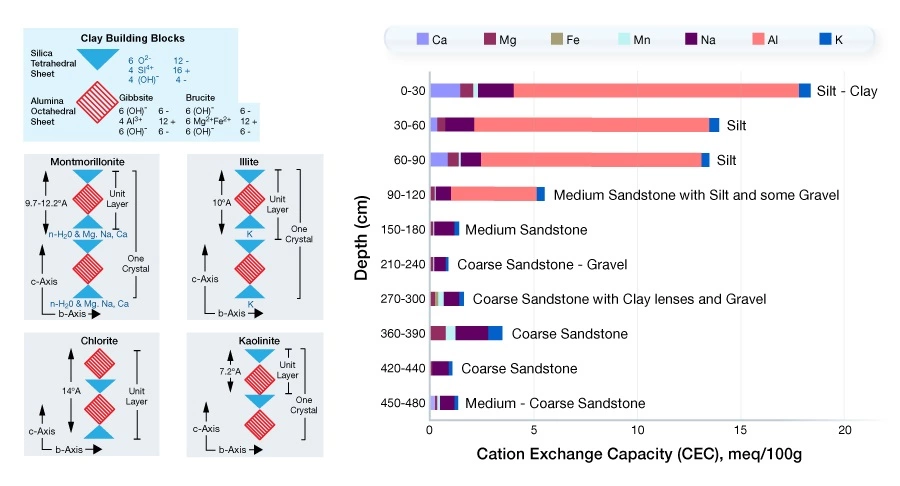
A water saturation equation was developed by Waxman and Smits (1968) to express the water saturation, Sw, in shaly sandstones as a function of the cation exchange capacity of the clay disseminated in the sandstone:
![Rendered by QuickLaTeX.com S_w = \sqrt[n^*]{\dfrac{F^{^*} \cdot R_w}{R_t \cdot \left( 1 + \dfrac{R_w \cdot B \cdot Q_v}{S_w} \right)}}](https://petroshine.com/wp-content/ql-cache/quicklatex.com-8d7cda7258dfaed2b433e08dffb3e65a_l3.png)
Where:
![]()
![]()
Sw= Formation water saturation
Rw= Formation water resistivity
Rt= True formation resistivity
F∗= Formation resistivity factor independent of clay conductivity ![]()
F= Formation resistivity factor
n∗= Saturation exponent independent of clay conductivity (slope of RI versus Sw plot)
B= Specific counterion activity, ![]()
Qv= Quantily of cation exchangeable clay present, ![]() of pore space
of pore space
CEC= Cation exchange capacity, ![]()
ρma= Grain density or raock matrix, ![]()
a= Tortuosity coefficient (intercept on F versus ϕ plot)
m∗= Cementation exponent (slope of F∗ vs ϕ plot)
ϕ= Measured porosity, fraction
The Waxman-Smits equation requires an iterative solution because Sw appears on both sides of the equation. This method, although based on sound laboratory measurements and good petrophysical principles, lacks one vital factor for its regular application the ability to derive CEC values from conventional well log measurements. Correlations for a given oil or gas field can be made between core measurements of CEC and other log measurements. However, the cores must be measured first. There is no practical means of using this method if only well log data are available.
Because shale conductivity is a function of the cation exchange capacities of the various types of clay minerals and their abundances, shale conductivity is influenced more by the surface area of the clay minerals than by the volume of the clay minerals. Experimental data confirms that fine grained clays exhibit higher exchange capacities than coarser grained forms of the same volume. Doveton notes that all shale indicators estimate the volume of the shale component but are not able to provide an explicit assessment of the grain size or clay mineralogical variation. Thus, without a tool that measures the CEC directly, it is difficult to design log analysis procedures that accommodate the cation exchange capacity data. Asquith (1990) notes that another objection to the Waxman-Smits equation is that it predicts that the effective water resistivities will decrease as water sandstones of constant formation water resistivity, Rw, become shalier, a point which Clavier et al. (1977) dispute with evidence to the contrary.
The dual water model devised by Clavier et al. (1977) circumvents some of the flaws found in the Waxman-Smits model and is indirectly based on the CEC.
Juhasz Method
Juhasz (1981) developed a system for assessing the shale distribution and determining the average shaliness, porosity and hydrocarbon saturation of shaly sandstone laminae. This system is derived partially from the relationship between the total porosity and shale volume described by Thomas and Stieber (1975), as well as the Waxman-Smits (1968) saturation model. Juhasz uses crossplots of the porosity versus shale volume to evaluate the formation (Figure 12).
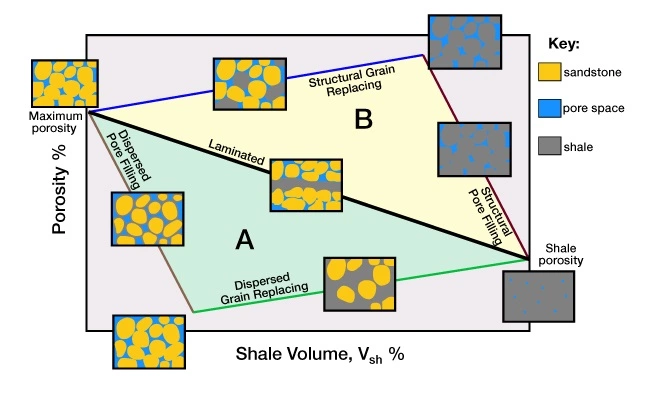
The overall evaluation process has been split into separate procedures to cover the total porosity system, as well as the effective porosity system.
Shale Distribution within the Total Porosity System
Juhasz uses the pattern and position of data points within the total porosity versus volume shale crossplot to evaluate the formation (Figure 13).
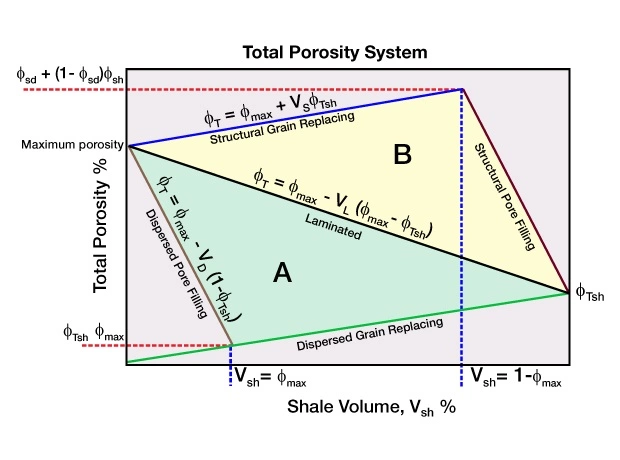
The positions of the lines used in the crossplot are based on the maximum clean sandstone porosity and the total shale porosity observed in the zone being evaluated. Juhasz assumes that only the combination of laminated and dispersed shale occurs in Triangle A of the clay distribution plots. In Triangle B, only the combination of laminated and structural shale occurs.
Crossplot Boundaries and End Points
The basic equations used to describe the different distributions of shale are also used to define key lines on the triangles:
- Laminated shale only Vsh=VL:
 Triangles A and B
Triangles A and B - Dispersed shale only Vsh=VD:
 Triangle A
Triangle A - Structural shale only Vsh=VS:
 Triangle B
Triangle B - Material balance for shale:

Where:
VL= Shale volume: laminated
VD= Shale volume: dispersed
VS= Shale volume: structural
Vsh= Shale volume
ϕT= Total porosity
ϕmax= Maximum porosity: clean sand porosity
ϕTsh= Total porosity: shale
Triangle A, which is used only to describe laminated or dispersed shales, is defined by three points:
- Sand: ϕmax, such that Vsh=0%
- Shale: ϕTsh, such that Vsh=100%
- Sand: in which all porosity is entirely filled by dispersed shale
 , such that
, such that 

Triangle B, which is used only to describe laminated or structural shales, shares two of three points in common with the other triangle:
- Sand: ϕmax, such that Vsh=0%
- Shale: ϕTsh, such that Vsh=100%
- Sand: in which all grains have been entirely replaced by structural shale:
![Rendered by QuickLaTeX.com \left[ \phi _{max} + (1 - \phi _{max}) \cdot \phi _{Tsh} \right]](data:image/svg+xml;base64,PHN2ZyB4bWxucz0iaHR0cDovL3d3dy53My5vcmcvMjAwMC9zdmciIHdpZHRoPSIxOTgiIGhlaWdodD0iMTkiIHZpZXdCb3g9IjAgMCAxOTggMTkiPjxyZWN0IHdpZHRoPSIxMDAlIiBoZWlnaHQ9IjEwMCUiIHN0eWxlPSJmaWxsOiNjZmQ0ZGI7ZmlsbC1vcGFjaXR5OiAwLjE7Ii8+PC9zdmc+) , such that Vsh=1 − ϕmax
, such that Vsh=1 − ϕmax
The equations of the lines that describe the triangles can be used to calculate the individual shale fractions, VL , VD and VS, and the porosity of the sandstone laminae can be calculated for any total porosity and shale volume data pair in the plot.
Choosing the Appropriate Triangle
The evaluation begins by selecting the correct shale distribution triangle. To do so, the shale volume must be compared with the theoretical amount of laminated shale, VL, which would be required to yield the total porosity:
![]()
The result will fall into one of three categories:
1. Vsh=VL, in which only laminated shale is present, such that
VD=0
VS=0, and
ϕTs=ϕmax
In this case, all data pairs will plot along the common hypotenuse shared by both triangles.
2. Vsh<VL, in which only laminated or dispersed shales are present in this case, all data pairs plot within Triangle A, such that:
![]()
The amount of dispersed shale can be determined by relating it to total bulk volume:
![]()
![]() (No structural shale will be plotted within Triangle A)
(No structural shale will be plotted within Triangle A)
The shale content of the sand laminae (VDs are derived from VD corrected for the reduced bulk volume of the sand laminae;
![]()
Juhasz then expresses the porosity of the sand laminae (ϕTs) by the relation:
![]()
3. Vsh>VL, in which only laminated or structural shales are present in this case, all data pairs plot within Triangle B, such that:
![]()
The amount of structural shale can be determined by relating it to total bulk volume:
![]()
![]() (No dispersed shale will be plotted within Triangle B)
(No dispersed shale will be plotted within Triangle B)
The structural shale content of the sand laminae (VSs) are derived from Vs correct for the residue bulk volume of the sand laminae:
![]()
The porosity of the sand laminae are again expressed by the equation:
![]()
Hydrocarbon Saturation in the Total Porosity System
Assuming that all the hydrocarbons are contained within the sandstone portion of a shaly sandstone, Juhasz expresses the hydrocarbon saturation in the sandstone as:
![]()
Where:
ShTs = Total hydrocarbon saturation in the sand
ϕT = Total porosity
ShT = Total hydrocarbon Saturation
VL = Shale volume: laminated
ϕTs = Total porosity: sand
Shale Distribution in the Effective Porosity System
Juhasz uses an approach for evaluating the shale distribution in the effective porosity system that is structured similarly to the technique for the total porosity system. This approach, however, uses a crossplot of the effective porosity versus the shale volume (Figure 14).
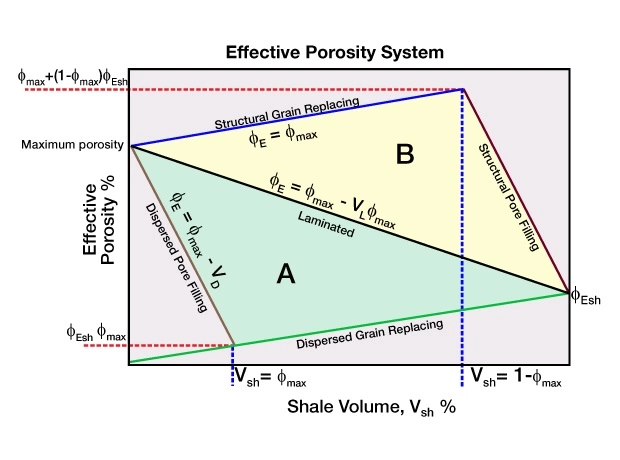
Using the equation for effective porosity as: ϕE=Vsh⋅ϕTsh. Juahasz assumes that shale’s bound-water does nor contrubute to effective porrosity, and therefore:
![]()
Where
ϕEsh = Effective porosity in shale
ϕTsh = Total porosity in dhale
Vsh = Shale volume
Crossplot Boundaries and End Points
Juhasz uses the equations that describe different distributions of shale to define key lines on the effective porosity triangles:
- Laminated shale only (Vsh=VL):
 Triangles A and B
Triangles A and B - Dispersed shale only (Vsh=VD):
 Triangle A
Triangle A - Structural shale only (Vsh=VS):
 Triangle B
Triangle B
Where:
VL = Shale volume: laminar
VD = Shale volume: dispersed
VS = Shale volume: structural
Vsh = Shale volume
ϕE= Effective porosity
ϕmax= Maximun porosity: clean sand porosity
Triangle A, which is used only to describe laminated or dispersed shales, is defined by three points:
- Sand: ϕmax, such that Vsh=0%
- Shale: ϕEsh, such that Vsh=100%
- Sand: in which all porosity is entirely filled by dispersed shale: (ϕEsh⋅ϕmax), such that Vsh= ϕmax
Triangle B, which is used only to describe laminated or structural shales, shares two of three points in common with the other triangle:
- Sand: ϕmax, such that Vsh=0%
- Shale: ϕEsh, such that Vsh=100%
- Sand: in which all grains have been entirely replaced by structural shale:
[ϕmax+(1−ϕmax)⋅ϕEsh], such that Vsh=1 − ϕmax
Choosing the Appropriate Triangle
The evaluation begins by selecting the appropriate shale distribution triangle.
Similar to the previous discussion on the total porosity system, we use shale volume and effective porosity data pairs to calculate the theoretical value of VL which should be required to satisfy the effective porosity in the case of laminated shale distribution:
![]()
A comparison of the above VL to the actual shale volume will lead to one of three results:
1. Vsh=VL, in which only laminated shale is present, such that:
![]()
Porosity of the sand laminae is expressed by the equation:
![]()
In this case, all data pairs of ϕE and Vsh will plot along the common hypotenuse shared by both triangles.
2. Vsh<VL, in which only laminated or dispersed shales are present in this case, all data pairs plot within Triangle A, such that:
![]()
The volume of dispersed shale within the sand laminae is expressed as:
![]()
Juhasz then expresses the porosity of the shaly sand laminae by the relation:
![]()
3. Vsh>VL, in which only laminated or structural shales are present in this case, all data pairs plot within Triangle B, such that:
![]()
The amount of structural shale can be determined by relating it to total bulk volume:
![]()
![]() (No dispersed shale will be plotted within Triangle B)
(No dispersed shale will be plotted within Triangle B)
The shale content of the sand laminae are derived from Vs corrected for the reduced bulk volume of the sand laminae:
![]()
The porosity of the sand laminae are again expressed by the equation:
![]() or
or
![]()
Hydrocarbon Saturation in the Effective Porosity System
Assuming that all hydrocarbons are contained within the sandstone portion of a shaly sandstone, Juhasz expresses the hydrocarbon saturation in the sandstone as:
![]()
Where:
ShEs = Effective hydrocarbon saturation in the sand
ϕEs= Effective porosity in sand
ShE = Effective hydrocarbon saturation
VL = Shale volume: laminated
Guidelines for When to Use the Different Log Interpretation Methods
- When the clay is dispersed or when the clay or shale distribution is not known, use either the dispersed clay or Fertl method.
- If the shale is laminated, use the Simandoux, dual water or Juhasz method.
- When the clay is dispersed and the resistivity of the dispersed clay is known to be the same as the adjacent shale (bioturbated or turbidite shaly sands), use the Simandoux or dual water method.
- If the resistivity of the dispersed clay in the shaly sand is known, or you feel comfortable in assuming that the resistivity of the dispersed clay (Rcl) is equal to 0.4 times (Fertl and Hammack, 1971) the resistivity of the adjacent shale (Rsh), then use the Simandoux or dual water method.
- In areas where formation water resistivities are high (Rw > 0.1 ohm-m), water saturations calculated by the Fertl (1975) and the dispersed clay methods should be used with caution, because it is assumed in both equations that Rsh > Rw; however, in shaly sands with high formation water resistivities, this assumption may not be true. If Rsh ≅ Rw, use the dual water method.
- When cation exchange capacity data is available, use the Waxman-Smits-Thomas method, irrespective of the shale distribution type.
 Petro Shine The Place for Oil and Gas Professionals.
Petro Shine The Place for Oil and Gas Professionals.
